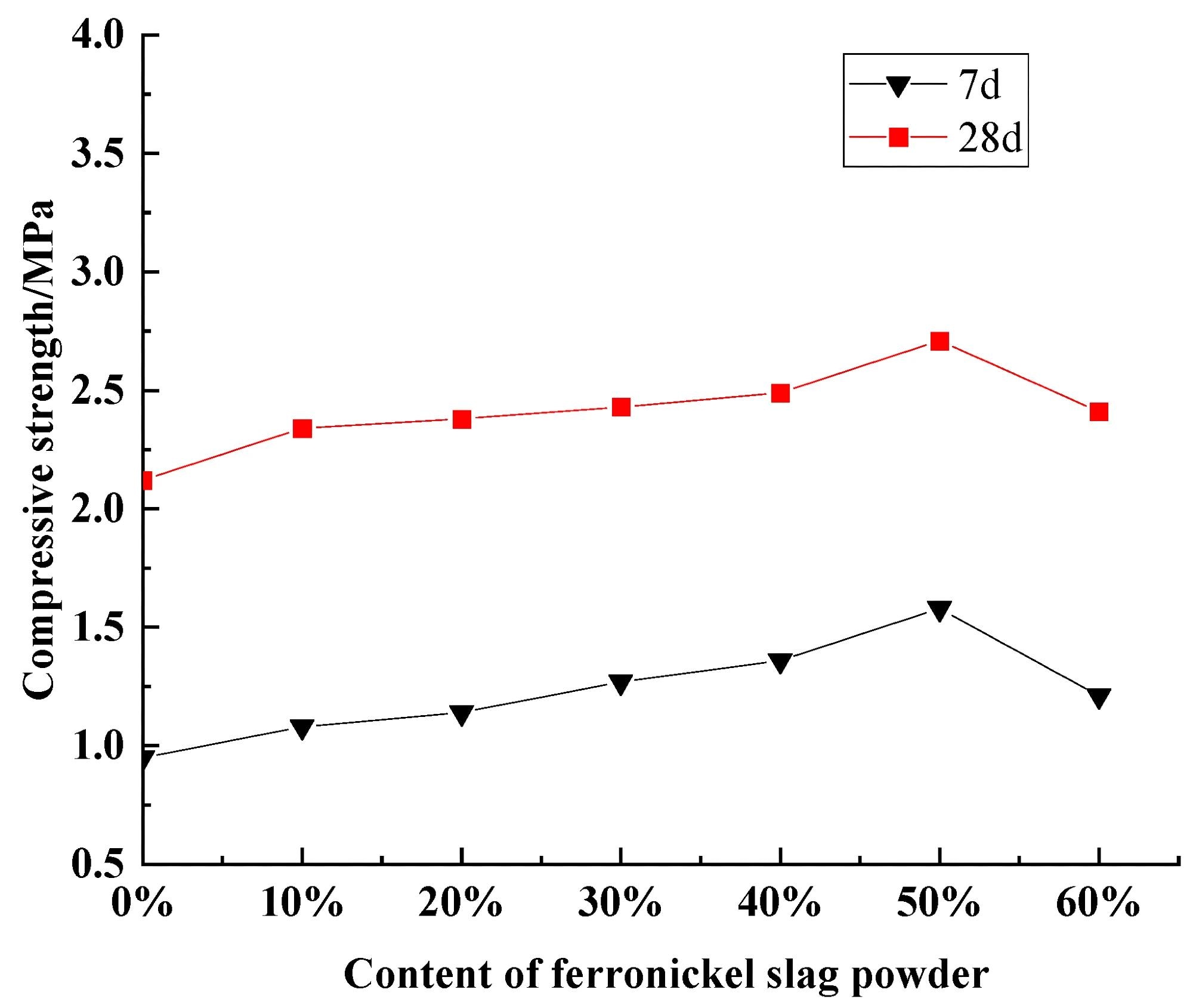 By Nidhi DhullReviewed by Susha Cheriyedath, M.Sc.Jun 11 2024
By Nidhi DhullReviewed by Susha Cheriyedath, M.Sc.Jun 11 2024A recent article published in Coatings investigated the hydration behavior and performance of ferronickel slag powder soil cement, analyzing its mechanical strength and microstructure under freshwater curing conditions.
 Relationship curve between compressive strength of soil cement and ferronickel slag powder content in freshwater environment. Image Credit: https://www.mdpi.com/2079-6412/14/6/721
Relationship curve between compressive strength of soil cement and ferronickel slag powder content in freshwater environment. Image Credit: https://www.mdpi.com/2079-6412/14/6/721
Background
Soil cement is a common construction material, widely used in building structures and foundation works. It offers the advantages of locally sourced materials, flexible construction, low environmental impact, and reduced cement usage.
As the construction industry is transitioning to sustainability, industrial by-products such as slag and fly ash are being used to optimize and improve soil cement properties. For example, ferronickel slag is a solid waste produced by smelting nickel-iron alloy. It has the potential chemical activity to partially replace cement and improve the mortar’s porosity and flow. However, the disproportionate addition of slag might decrease the mortar’s mechanical strength.
Mechanical grinding and steam curing help activate the pozzolanic materials in ferronickel slag, improving the mortar’s mechanical strength and pore network. Therefore, this study explored the hydration mechanism and functionality of ferronickel slag powder soil cement cured in freshwater.
Methods
The soil used in this study was obtained from the silt of a construction pit in China. The composite ferronickel slag powder was sourced from a blast furnace, containing ferronickel slag and granulated ore powders in a mass ratio of 2:1.
The silt from the construction pit was air-dried, crushed, and oven-dried. Subsequently, an appropriate quantity of purified water, cement, and ferronickel slag powder was measured and blended in a mortar mixer to form a consistent cement slurry. This slurry was mixed thoroughly with the wet soil for over five minutes to obtain the final soil cement slurry.
Purified water was used in all experiments, which helps avoid the influence of corrosive elements like Cl− in tap water. The soil cement samples were demolded after 24 hours and soaked in pure water at room temperature until the defined age. Samples with 0 %, 30 %, 45 %, and 60 % of nickel-iron slag powder admixture were selected for the study.
The influence of ferronickel slag powder content and curing age on the soil cement’s compressive strength and damage state was investigated through unconfined compressive tests. Additionally, a splitting tensile test was performed after 28 days of curing. The water-to-cement ratio, cement incorporation, admixture content, and curing conditions were the same during both these tests.
Scanning electron microscopy (SEM) was performed to analyze the microstructure of soil cement. In addition, nuclear magnetic resonance (NMR) spectroscopy was performed to examine the effect of different ferronickel slag powder contents, wet-dry cycles, and load cycles on the soil cement’s internal pore structure.
Results and Discussion
The ferronickel slag powder enhanced the compressive strength of soil cement up to an inclusion rate of 50 %. Beyond this concentration, compressive strength decreased. However, according to relevant regulations, the optimal content of ferronickel slag in soil cement was found to be 45 %.
Incorporating ferronickel slag also enhanced the soil cement’s tensile strength, with the optimal ferronickel slag powder content being 45 %. However, the compressive strength was approximately six to eight times the tensile strength, primarily exhibiting brittle failure.
SEM analysis revealed calcium silicate hydrates (C-S-H) as the primary hydration products within soil cement, which increased with adding slag up to a point and then decreased. At 28 days, the ferronickel slag powder started exhibiting a pozzolanic effect, undergoing a hydration-like reaction. However, excessive ferronickel slag powder weakened the hydration reaction due to insufficient cement content, reducing the soil cement strength.
The NMR data demonstrates a transformation from larger to smaller internal pores in the soil cement with increasing slag content, which reduced the total pore volume and resulted in a denser structure. Further, the pseudocolor magnetic resonance images depicted a gradual decrease in larger internal pores and an increase in smaller ones, enhancing the continuity in pore size distribution within the soil cement.
Conclusion
Overall, the researchers investigated the effects of different ferronickel slag powder contents on the compressive and tensile strengths and the internal pore structure of soil cement in a freshwater curing environment.
The results of the unconfined compression and splitting tensile tests demonstrated the increase in compressive and tensile strength of soil cement upon adding ferronickel slag powder. The maximum increment was observed for 45 % content of ferronickel slag powder. Additionally, microscopic examinations revealed that excessive doping of ferronickel slag powder would weaken the hydration reaction and decrease the strength of the soil cement.
Simultaneously, ferronickel slag powder helped fill the void of soil cement. As the amount of ferronickel slag powder increased, the large pores inside the soil cement were reduced, and the structure became denser. The comprehensive analysis outlined in this study can deepen understanding of the impact mechanisms of ferronickel slag powder on soil cement properties and serve as theoretical and practical guidance for optimizing the performance of soil cement.
Journal Reference
Liu, L., Chen, S., Chen, F., He, L., & Chen, W. (2024). Performance of Ferronickel Slag Powder Soil Cement under Freshwater Curing Conditions. Coatings, 14(6), 721. https://doi.org/10.3390/coatings14060721, https://www.mdpi.com/2079-6412/14/6/721
Disclaimer: The views expressed here are those of the author expressed in their private capacity and do not necessarily represent the views of AZoM.com Limited T/A AZoNetwork the owner and operator of this website. This disclaimer forms part of the Terms and conditions of use of this website.
Article Revisions
- Jun 12 2024 - Title changed from "Optimal Ferronickel Slag Use in Soil Cement" to "Enhancing Soil Cement with Ferronickel Slag"